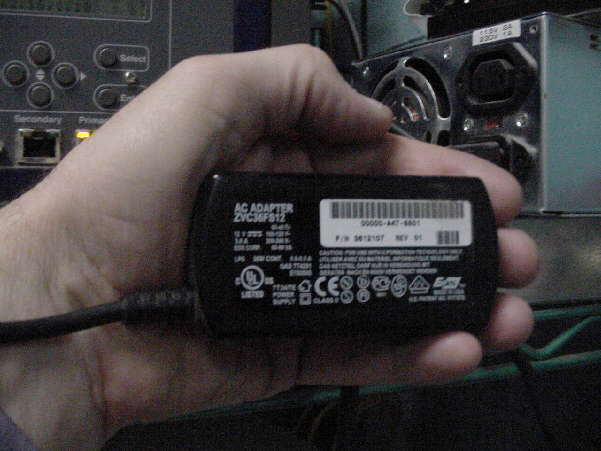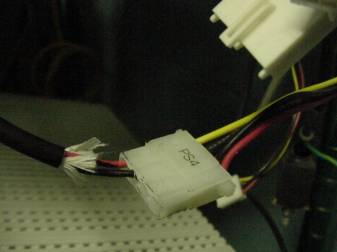Gateway
Microserver / Cobalt Qube 2
Power problems
2005
Update - 2016 These items are useless. You
can buy a NAS for pretty cheap and a 500 Gb drive for $40 each. These 8GB
drive are history.
You can get hosting for $3 a month. These are no way
to be used on the internet, they will get hacked fast.
Update 2 - 2007, that Qube
2 started to have problems again, the Qube 2 would lock-up.
I changed to a PC power supply. I
also moved the extra memory chip to the outside slot.
I"ll post if the problem clears up.
Two weeks later: Nope...
the Qube 2 still has locking problems. I have some Qube 3 computers I will
be using soon. Something is not right with it.
Back in 2001, they were amazing. An 8 Gb server in
you own home/office. Intranet, file storage, your own web site ! ! Now you
can't find HD smaller then 300Gb.
UPDATE 2015
- There are many programs to allow a old PC to turn into a server for free.
Plus it has current technologies and they are secure enough for a website and
they have updates. Plus you can add any size HD you wish, and with the many NAS systems available for backup/storage and the cost of web
site for only a few dollars per month. These are old technologies.
The software is very hackable, never use them for outside web sites. So
the below information is very outdated and unsuitable for in-house storage.
I have a few Qube 2 microservers.
They were also sold by Gateway as microservers. These easy to use web
servers/FTP servers were top rated back in 1998. Now, they are on E-bay
for around $100. or less. The only
problems are the power supplies are very small and don't last, also the hard
drive are dying from just age. There are ways to replace the HD but you
must find one that works with it, not many hard drives do. Plus there is a
30 Gig limit to the BIOS of the machine according to some sites. Even if
you find a HD you need the boot CD-ROM and a specific NIC (network card) to
install the software. After a couple hours install, you must apply a bunch
of updates taking another 45 min with many reboots.
There is an EOL (End Of Life) CD available from cobalt.
That's if you know how to make an "image" cd.
My problem started with the Microserver
crashing. After getting a Gateway Microserver for some $50 on E-bay, and
being on for a year, the server would just crash if I tried to FTP to it and
would take 3 or 4 tried to start it.
I though the whole server was bad, as it
would just reboot and sometimes only the cooling fan would start and stop just
try to get stared.
 |
The power plug has a safety on it.
You must pull back the cover then pull out the plug.
This keeps the plug in should it be pulled by accident.
Don't try to just yank the Qube 2 power plug out.
I
checked the power supply with a voltage tester and it showed 12 volts. I
took that power supply to work, where I had another Qube 2, and tried it.
Using that power supply, it did the same thing to that working Qube 2, just
rebooted and restarted. So off to find a new power supply. The
original power supply is 12 volts and 1.2 amps. Nothing fancy. After
popping the old tiny power supply apart I saw the tiny the transformer that was
powering the CPU and HD. The photo show the tiny power supply.
|
I could only locate a 12 volt converter in
my house I used for a rechargeable flashlight that I needed.
So I still needed something else as a replacement. I saw an old
computer power supply sitting in my junk box. I used it for testing old
computers and hard drives. To try my suspicions that it was just a faulty
power supply I cut the wires to the old Qube 2 power supply. It's a very
basic setup, the red wire cut from the old Qube power supply is the +12 volts
and the black is ground. This PC power supply was the old "click on -
click off" type. First off, the wires to the PC's power supply
"ON-OFF" switch are always a live 120V and they are covered in
plastic. I still put black electrical tape around that connection part.
Knowing that the 4 pin power cord that goes to the back of a PC's hard drive
from this old power supply can carry some 4 amps. I used one of the black wire
nearest the YELLOW wire to connect to the black wire and the YELLOW wire (+12)
to the RED power wire.
| By just stripping the
wires back, twisting the ends to keep them straight they will shove in
nicely to those connectors. Fold them over the former HD connector
and electrical tape them in place. Yes, there is a red wire on those
connectors but that is just 5 volts. Pushing the ON button to the PC
power supply and the power supply's fan will spin showing you have
power. These old power supplies will work if not plugged into a
computer. The newer power supplies need a jumper to "fool"
the power supply into starting without a motherboard connected. That
info you can find elsewhere, I won't get into that. |
 |
Lots of these old PC supplies
hanging around. Well I plugged in the round power cord to the microserver
and pressed the power button. Instantly the fan for the Qube 2 started to
spin and the "Qube 2" started to spring to life again, after some 4
month sitting with the top apart. After some 15 minutes
"checking disk" it showed the IP address on the LCD. I then
transferred some 1200 files to it and it's running like new. No blips or
hiccups.
So, if your old Gateway microserver or Qube
2 is giving you trouble, dying for no reason under power, it could just be fixed
with a $5 old PC power supply. The hard drive replacement is troublesome.
I will post the two types I have. There is info on the web about what HD
will work. Few HDs will and at 20 Gigs, they are no longer made unless you
are able to find a "new in the package" model. A number of HDs
will accept the startup disk and run the install in the Qube 2. Upon
reboot it will sit there with just "checking disk" or another LED
message. The Microserver has a IBM 10 Gig HD, Deskstar, dated 1999,
10 gig (30 gig was the largest available according to some sites), 7200 rpm,
DPTA-371020. My Qube 2 at work has a Segate ST320423A 20 Gb hard drive.
Interesting items. I had a problem
with one of the two Qube 2 server at my work. One, that is used as an
Intranet, has not been rebooted for a few years (only turned off by accident or
power failures). The other I use as a web server and crashed if left on
for more then two weeks straight. I don't remember if this started after I
added 128megs of memory or not. I recently removed the extra 128 meg
memory stick that I bought special for this machine. It was still unstable
and took forever to reboot every Friday so it wouldn't freeze over the weekend
("checking disk" for 15+ min). After reading about the placement
the memory chips on another site stating "making sure you used the larger
128meg chip in slot 0 which is the closest slot to the center chip", I
noticed the single chip was in slot 1. Since the cover was off
already (the HD is just sitting on the top of the bare unit) I quickly moved the
chip to slot 0. Rebooted and in less than 1 min, the unit showed the IP
address. Amazing. I'm trying that 128 meg chip in another Qube 2
with the new PC power supply and seeing if it will lock up. It's possibly
I had the chips backwards and those sites were correct about making sure the
larger memory chip is in slot 0. Of course the MB is not labeled at all.
After a week, the Qube 2 with the 128Mb chip closest to the CPU and the smaller
behind it, it ran fine and never locked up. So if you have stability
problems, even with the original 64 Mb chip, make sure it's in the slot closest
to the center CPU.

